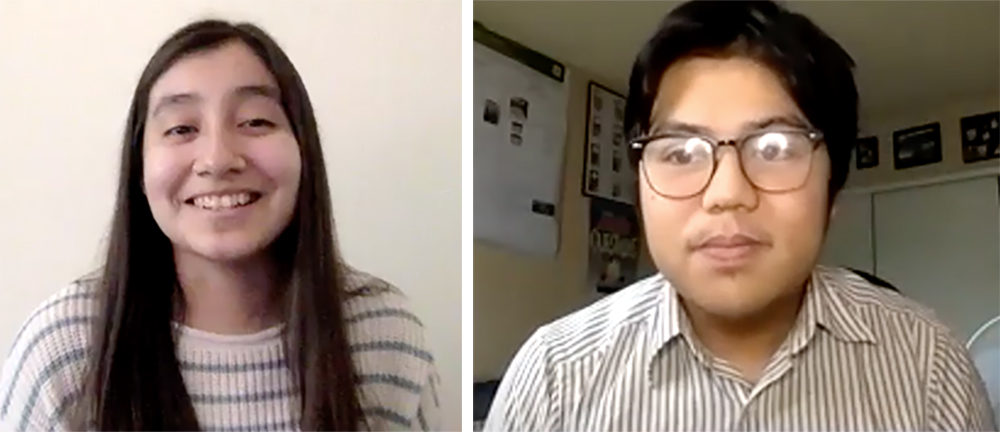Graduate Students Brenda Ramirez, and Justin Cortez will Represent CPP at the CSU Student Research Competition

Brenda Ramirez, graduate student, biology
Elizabeth Scordato’s Lab
PRESENTATION TITLE:
Natural and Anthropogenic Effects on Pacific swallow (Hirundo tahitica) Populations in southeast Asia
The study of bird populations often focuses on climate and environmental variables. This research also included the effects of human presence on habitats and projected what the placement and prevalence of habitats for the Pacific swallow were like over the last 6,000 years in comparison to today.
Faculty mentor Elizabeth Scordato said, “one of the strengths of her presentation was that she made the content accessible. She took huge datasets that can be very intimidating and did an incredible job. She was fearless.”
“Assistant Professor Scordato has been very supportive. She was always checking in and always available,” Brenda Ramirez said.
Their research has shown that as human land use has grown, habitats have increased due the availability of structures for nesting. The next step in the research will be to confirm an increase in suitable habitats has resulted in a growth in population.
This will be done using pairwise sequentially Markovian coalescent method. With this method, the researchers will be able to use current genome data to infer population distribution over time.
Ramirez plans to pursue a Ph.D. and wants to work as a conservation biologist. She acknowledges that, “The experience I gained at CPP using species distribution modeling is a valuable skillset I can use to monitor endangered species.”
Abstract:
Human activity has been a source of disturbance to ecological communities for thousands of years. Despite these drastic changes in land use over time, we currently have a poor understanding of how long-term human landscape alteration has affected distributions of suitable habitat and evolutionary processes in most species. The Pacific swallow (Hirundo tahitica) is a commensal species that can be found throughout southeast Asia and the Pacific that builds its nests on man-made structures. This commensal relationship with humans makes them the ideal system in which to study the effects human development has had on species distributions and demographic change over time. Species distribution models (SDMs) were created for the present and were also projected back 6,000 years to predict distributions of available habitat since the spread of agriculture in Southeast Asia. Our results show that annual precipitation and human population density have the largest effect on Pacific swallow habitat distributions. An increase in human land use has likely provided Pacific swallows with more nesting habitat, which may have led to an increase in population size over time. Including anthropogenic factors in studies of changes in habitat availability and demographic change over time is not commonly done but is essential because of the lasting impact humans have on the environment.
Justin Cortez, graduate student, chemistry and biochemistry
Chantal Stieber’s Lab
* Justin Cortez won first place in the Physical and Mathematical Sciences category at the 2021 CSU Student Research Competition.
PRESENTATION TITLE:
Synthesis of Nickel Fluoride Complexes with Bidentate N-Heterocyclic Carbene Ligands
Flourine is important to the production of pharmaceuticals, agrochemicals, and polymers. The Carbon-Flourine (C-F) bond is one of the strongest, making it difficult to break. While nickel catalysts have been used to activate C-F, this research is unique in its use of bidentate ligands that results in two binding sites in the metal complex. This adds stability. Research such as this could result in the discovery of better ways to make catalysts, and methods that could produce new types of medicines.
“Justin spearheaded this research which is a collaboration with Nicholas Ball at Pomona College, and discovered new directions for reactions relevant to pharmaceutical chemistry,” Stieber said. “We discovered a novel nickel complex with reactivity that had not been demonstrated before.”
It takes 2-3 weeks to make the nickel complex for the catalyst. The reaction that cleaves the (C-F) bond takes 24-48 hours.
The research requires verifying what has been made and that requires the use of fluorine nuclear magnetic resonance spectroscopy and an X-ray diffractometer, high end equipment that CPP is fortunate to have. The university got the XRD through a Department of Defense grant that Chantal Stieber acquired.
They’re continuing to conduct the research virtually, but Justin looks forward to being able to return to campus. Working remotely he utilizes various programs such as ChemDraw to construct chemical reaction diagrams and Avogadro to view crystal structures of metal complexes.
During his senior year as an undergrad Justin Cortez was headed to pharmacy school. After some soul searching, he decided to change course. He made the decision to become a high school chemistry teacher and attained his teaching credential before pursuing his master’s in chemistry.
“Justin’s passion for chemistry and learning is infectious and I am confident that he will inspire many future scientists in his teaching career,” faculty mentor Chantal Stieber said.
Abstract:
There is a great interest in stoichiometric and catalytic derivatization of fluorinated substrates via C-F activation and C-C coupling reactions at metal centers. This reflects the steadily increasing importance of fluorine containing pharmaceuticals, imaging agents, agrochemicals, polymers, optoelectronics, and high-performance materials. However, this poses a great challenge as C-F bonds are difficult to cleave and the kinetic inertness of the reaction hinders C-F activation. This is due to fluorine forming the strongest known bond to carbon. The high electronegativity of fluorine induces a significant ionic bond character resulting in a high polarity, a short bond, a low polarizability, and a low-lying antibonding orbital. One strategy for the synthesis or modification of fluoro-organic compounds involves the metal-mediated selective removal or the metal-mediated replacement of a fluorine atom from readily available precursors. For this research, a nickel bidentate N-heterocyclic carbene complex was utilized to promote the C-F activation by cleaving one C-F bond from C6F6 resulting in the formation of new Ni-C and Ni-F bonds in the product. This is a new example of C-F activation mediated by nickel.